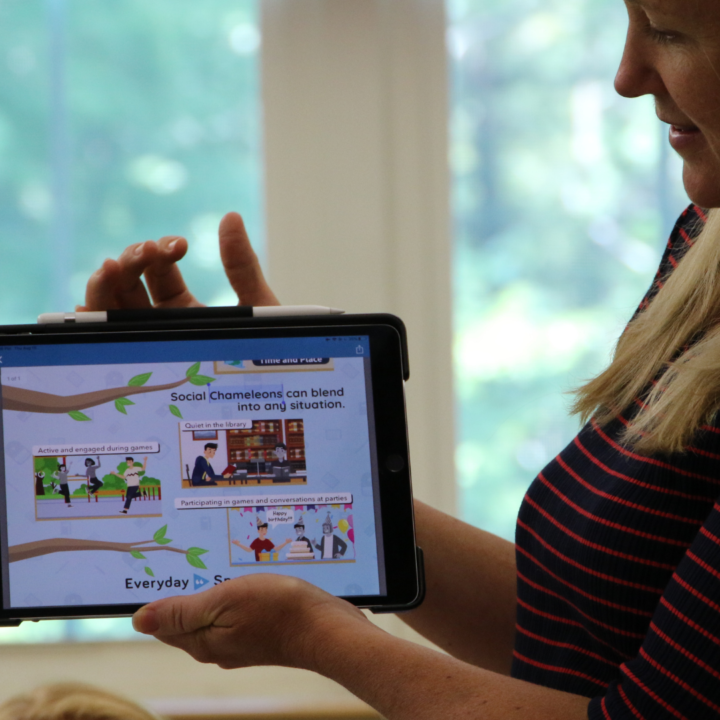In this post, we’ll share the concepts that guide our in-house clinical team in their creation process and discuss why we focus on video modeling for SEL.
All Everyday Speech resources are aimed at helping students develop the underlying skills needed to succeed socially and emotionally. We base our teaching method on the following four concepts:
Theory of Mind
To have successful social interactions we must first understand that everyone thinks and feels differently from ourselves. Psychologists refer to this as “Stable Theory of Mind.” We constantly gather outward social cues to understand situations and others’ thoughts, feelings, and needs. When our guesses at what someone else is thinking and feeling becomes the foundation for how we act, we are social.
That’s why our videos display a window into the brains of others’ inner thoughts and feelings. Through this consistent connection, learners begin to link their own words and actions with others’ thoughts and feelings.
Predicting Multivariate Outcomes
Almost every social decision is multivariate, meaning they require us to analyze more than one outcome at a time. When faced with a social decision, we must predict the impact of each option on others. Being social is the constant anticipation of what is likely to happen. Research suggest that impaired social skills are in fact deficits in prediction skills.
That’s why our videos model using and not using the new skill to show students different outcomes, strengthening the brain’s predictive and inferencing skills needed for socializing. It allows learners to view and analyze different outcomes that result from each behavior, strengthening the brain’s predictive and inference skills needed for socializing.
Recognizing Social Consequences
Every social decision we make has second- and third-order consequences for the future. For example, the way a child behaves at recess one day impacts future bids to play at recess on subsequent days. In order to imagine the consequences so that good social decisions can be made, one must observe how those consequences play out in the minds of others.
That’s why we lay out the consequences for every interaction. Our videos show the cognitive processes that occur before someone acts. For example, ‘What will people think if I say this statement versus that statement,’ or ‘What if I act this way versus that way?’
The following clip from our video, “Compromising with Others,” demonstrates how we combine the previous concepts into our materials. Can you spot how theory of mind, predicting multivariate outcomes, and recognizing social consequence come into play?
Why does Everyday Speech use Video Modeling?
Research shows that students learn faster and are more likely to retain and apply what they learn across contexts with interactive Video Modeling. Video Modeling has been found to be a particularly effective tool for teaching children with Autism Spectrum Disorder (ASD).
- The visual nature of video modeling can help accommodate for difficulties with executive functioning skills and information processing.
- A meta-analysis of 26 different studies found Video Modeling had a 53% improvement rate from baseline to intervention phase on enhancing social and communication skills for children with ASD.
- Video Modeling was a fast and effective tool for teaching perspective-taking tasks to children with autism. These results concurred with previous research that perspective taking can be taught (source).
That’s why we offer a 400+ video library full of videos for every type of learner. Our videos contain contrasting behaviors, thought bubbles, visuals on screen, animations, and more. We offer a unique tool you can’t find anywhere else!
Related blog: What is Social-Emotional Learning (SEL) and Why is it Important?
“As an SLP whose entire caseload in on the spectrum, Everyday Speech is a life-saver! It provides the framework for 90% of my lessons for students working on social pragmatic skills. Worth every penny.”
– Kate Nelson, M.S., CCC-SLP






